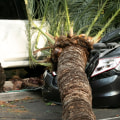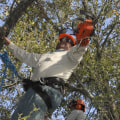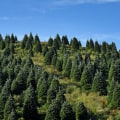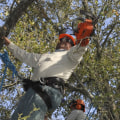Dead or dying branches that hang low, lack bark and have no leaves Weak, V-shaped branch joints where two branches have grown together. Discolored, moist, peeling, or tearful bark may indicate that a tree is sick. Bark is the outer layer of a tree that provides protection. When he can't do his job, the rest of the tree also suffers.
Therefore, damage to the outside of a tree can be more dangerous than it seems. Significant damage to the outside of a tree can kill it completely. If your tree has wilted leaves, pay attention. The leaves are the farmers of a tree, who collect sunlight and transform it into food energy.
But if they wither, they don't work at full capacity and the whole tree suffers. If your trees aren't stressed by heat or drought, leaf wilting may mean something different. If you have flooded soil that doesn't drain well, wilted leaves may be an indication. In this case, it is the lack of oxygen that causes wilting, since too much water is drowning the leaf tissue.
How can you distinguish between leaves on trees that wither from heat or drought stress and those that wither from excess water? While both conditions cause leaf tips and edges to brown and die, leaves stressed by heat and drought will be browner and drier overall, while overwatered leaves will be soft and loose. Other causes of leaf wilting include diseases, such as fire plague, which appears during hot and rainy spring weather. Fire blight is a bacterial disease that affects plants of the rose family, including apple and pear trees. Infected leaves wither and look burned.
The signs that a tree is dying are many and differ a lot. A sure sign is the lack of leaves or a reduction in the number of leaves produced on all or part of the tree. Other signs of a sick tree include bark becoming brittle and falling off the tree, branches dying and falling off, or trunk becoming fluffy or brittle. Integrity Tree Care 5304 Carol Ave Indian Trail, NC 28079. Sometimes the symptoms of tree decay are obvious.
Leaves don't appear in spring. Large strips of bark disappear from the trunk. Branches dry out and fill with wood-boring pest holes. Decaying trees can be dangerous, as recent events have shown.
Since February, five people have died from falling trees in Canton, Lyndeborough, N, H. Trees showing signs of decay and instability should be removed from the area as soon as possible. Whole trees that fall on a neighbor's property are stories that aren't uncommon, so it's one thing to do keep in mind too. However, if bark loss is due to an infectious disease, you will need to cut down the tree before the infection spreads to other trees in the area.
Choosing trees with thick, protected leaves adapted to windy and salty conditions is the best way to minimize wind damage; save the most delicate trees for protected areas. Unless you're an arborist or a tree expert, it's hard to spot the telltale signs that a tree is rotting and dying. For fungal or bacterial infections, look for cankers (discolored or depressed areas in the bark) or fungi that grow on the ground at the base of a tree or on the tree itself. The buds or flowers of the tree turn black and wither in the form of a shepherd's crook when a tree suffers from a fire plague.
Tree diseases vary from species to species, as do the types of insects and fungi that can damage various types of trees. You may need to repeat the test on several areas of the tree to determine if the entire tree is dead or only a few branches. While most trees are hardy for decades or even centuries, they can be affected by tree diseases, insects, fungi, and even old age. Infected trees could fall soon after showing obvious symptoms, so you should remove the tree if you see signs of this fungus.
I want to know what's wrong with it and how to treat the tree if I can, or how to replace the tree if I can't treat it. .





